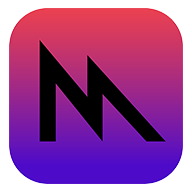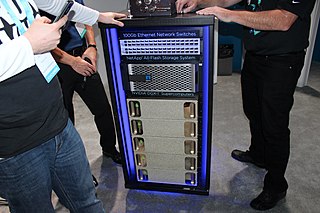
Nvidia Corporation is an American multinational technology company incorporated in Delaware and based in Santa Clara, California. It is a software and fabless company which designs graphics processing units (GPUs), application programming interface (APIs) for data science and high-performance computing as well as system on a chip units (SoCs) for the mobile computing and automotive market. Nvidia is a dominant supplier of artificial intelligence hardware and software. Its professional line of GPUs are used in workstations for applications in such fields as architecture, engineering and construction, media and entertainment, automotive, scientific research, and manufacturing design.

In computing, floating point operations per second is a measure of computer performance, useful in fields of scientific computations that require floating-point calculations. For such cases, it is a more accurate measure than measuring instructions per second.

The MacBook Pro is a line of Mac laptops made by Apple Inc. Introduced in January 2006, it is the higher-end lineup in the MacBook family, sitting above the consumer-focused MacBook Air. It is currently sold with 13-inch, 14-inch, and 16-inch screens, all using Apple silicon M-series chips.
The transistor count is the number of transistors in an electronic device. It is the most common measure of integrated circuit complexity. The rate at which MOS transistor counts have increased generally follows Moore's law, which observed that the transistor count doubles approximately every two years. However, being directly proportional to the area of a chip, transistor count does not represent how advanced the corresponding manufacturing technology is: a better indication of this is the transistor density.

Larrabee is the codename for a cancelled GPGPU chip that Intel was developing separately from its current line of integrated graphics accelerators. It is named after either Mount Larrabee or Larrabee State Park in Whatcom County, Washington, near the town of Bellingham. The chip was to be released in 2010 as the core of a consumer 3D graphics card, but these plans were cancelled due to delays and disappointing early performance figures. The project to produce a GPU retail product directly from the Larrabee research project was terminated in May 2010 and its technology was passed on to the Xeon Phi. The Intel MIC multiprocessor architecture announced in 2010 inherited many design elements from the Larrabee project, but does not function as a graphics processing unit; the product is intended as a co-processor for high performance computing.

A nettop is a small-sized, inexpensive, low-power, legacy-free desktop computer designed for basic tasks such as web browsing, accessing web-based applications, document processing, and audio/video playback.

Arm is a British semiconductor and software design company based in Cambridge, England. Its primary business is in the design of ARM processors (CPUs). It also designs other chips, provides software development tools under the DS-5, RealView and Keil brands, and provides systems and platforms, system-on-a-chip (SoC) infrastructure and software. As a "holding" company, it also holds shares of other companies. Since 2016, it has been owned by Japanese conglomerate SoftBank Group.
This list compares various amounts of computing power in instructions per second organized by order of magnitude in FLOPS.

Xeon Phi was a series of x86 manycore processors designed and made by Intel. It was intended for use in supercomputers, servers, and high-end workstations. Its architecture allowed use of standard programming languages and application programming interfaces (APIs) such as OpenMP.
Atom is a system on a chip (SoC) platform designed for smartphones and tablet computers, launched by Intel in 2012. It is a continuation of the partnership announced by Intel and Google on September 13, 2011 to provide support for the Android operating system on Intel x86 processors. This range competes with existing SoCs developed for the smartphone and tablet market from companies such as Texas Instruments, Nvidia, Qualcomm and Samsung. Unlike these companies, which use ARM-based CPUs designed from the beginning to consume very low power, Intel has adapted the x86-based Intel Atom line of CPU developed for low power usage in netbooks, to even lower power usage.

This article presents a detailed timeline of events in the history of computing from 2010 to 2019. For narratives explaining the overall developments, see the history of computing.

Metal is a low-level, low-overhead hardware-accelerated 3D graphic and compute shader API created by Apple, debuting in iOS 8. Metal combines functions similar to OpenGL and OpenCL in one API. It is intended to improve performance by offering low-level access to the GPU hardware for apps on iOS, iPadOS, macOS, and tvOS. It can be compared to low-level APIs on other platforms such as Vulkan and DirectX 12.
This is a timeline of Intel, one of the world's largest semiconductor chip makers.
An AI accelerator is a class of specialized hardware accelerator or computer system designed to accelerate artificial intelligence and machine learning applications, including artificial neural networks and machine vision. Typical applications include algorithms for robotics, Internet of Things, and other data-intensive or sensor-driven tasks. They are often manycore designs and generally focus on low-precision arithmetic, novel dataflow architectures or in-memory computing capability. As of 2018, a typical AI integrated circuit chip contains billions of MOSFET transistors. A number of vendor-specific terms exist for devices in this category, and it is an emerging technology without a dominant design.

Nvidia DGX is a line of Nvidia-produced servers and workstations which specialize in using GPGPU to accelerate deep learning applications. The typical design of a DGX system is based upon a rackmount chassis with motherboard that carries high performance x86 server CPUs. The main component of a DGX system is a set of 4 to 16 Nvidia Tesla GPU modules on an independent system board. DGX systems have large heatsinks and powerful fans to adequately cool thousands of watts of thermal output. The GPU modules are typically integrated into the system using a version of the SXM socket.

AMD Instinct is AMD's brand of professional GPUs. It replaced AMD's FirePro S brand in 2016. Compared to the Radeon brand of mainstream consumer/gamer products, the Instinct product line is intended to accelerate deep learning, artificial neural network, and high-performance computing/GPGPU applications.
Raja M. Koduri is an Indian-American computer engineer and executive for computer graphics hardware. He was the chief architect and Executive Vice President of Intel's architecture, graphics and software (IAGS) division until April 2023. Before Intel, he worked as the senior vice president and chief architect of the Radeon Technologies Group, the graphics division at Intel's competitor AMD.

Intel Xe, earlier known unofficially as Gen12, is a GPU architecture developed by Intel.

Ampere Computing LLC is an American fabless semiconductor company based in Santa Clara, California that develops cloud native server microprocessors (CNPs). Ampere also has offices in: Portland, Oregon; Taipei, Taiwan; Raleigh, North Carolina; Bangalore, India; and Ho Chi Minh City, Vietnam.














